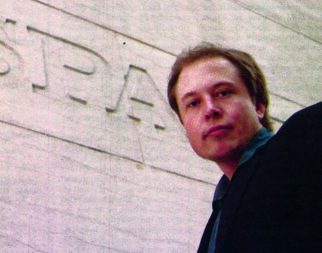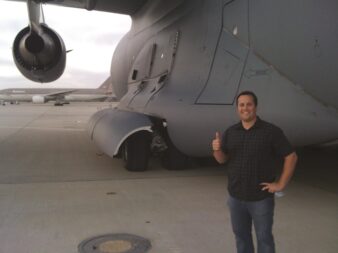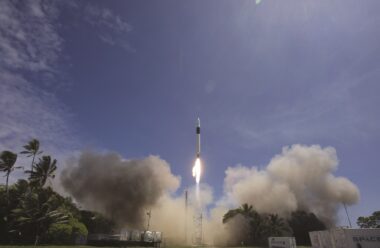Book excerpt | Liftoff: Elon Musk and the Desperate Early Days That Launched SpaceX
By Liz Pillow

A fat, red sun sank into the Texas horizon as Elon Musk bounded toward a silvery spaceship. Reaching its concrete landing pad, Musk marveled up at the stainless steel, steampunk contraption looming above, which shone brilliantly in the dying light. “It’s like something out of a Mad Max movie,” he gushed about the first prototype of his Mars rocket, nicknamed Starhopper.

Musk traveled to his South Texas rocket factory in mid-September 2019 to track progress of SpaceX’s Starship vehicle, the culmination of nearly two decades of effort to move humans from Earth to Mars. Weeks earlier, Starhopper soared into the clear skies above the coastal scrubland, located just this side of the Mexico border. And then, it very nearly crashed. Luckily, the Federal Aviation Administration had restricted the flight’s maximum altitude to five hundred feet, so when engineers lost control during Starhopper’s descent its landing legs merely crushed through the pad’s steel-reinforced concrete, rather than erupting into a ball of flame. Musk laughed at this thought. For much of SpaceX’s lifetime he has fought against regulators, always seeking to go faster, to push higher. “This time,” he quipped, “the FAA saved us.”
This was his first visit to Starhopper since. Musk made the rounds, high-fiving a handful of employees and enjoying the moment with three of his sons who had come along for the weekend trip from Los Angeles. Starhopper, he explained to the boys, is made from stainless steel, the same stuff in pots and pans.
This stainless steel, however, had the look of being left on a stovetop’s open flame for too long. The evening’s deepening darkness could not mask extensive charring on the metal. Standing beneath Starhopper, Musk peered upward into the cavern housing a large fuel tank that had fed propellant to a Raptor rocket engine. “It’s in remarkably good shape considering we had an inferno in there,” he said.
Elon Musk traveled a long road to reach these plains rolling down to the Gulf of Mexico. In 2002, Musk founded SpaceX with the intention of eventually building spaceships that would take hundreds, and then thousands, of human settlers to Mars. Though a cold, likely dead, and nearly airless world, Mars nonetheless offers humanity the best place to expand beyond Earth. Mars has polar ice caps, useful chemicals in its thin atmosphere, and material to scratch out a living. It also is relatively close, as planets go.
Over the years, Musk has accomplished a number of remarkable feats with SpaceX, flying astronauts into space, landing rockets on boats, and remaking the global aerospace industry. But those achievements pale next to the audacity of trying to send humans to Mars, which remains far beyond the present-day capability of NASA or any other space agency around the world. Even with an annual budget approaching $25 billion a year, and some of the smartest scientists and engineers anywhere, the space agency that landed humans on the Moon remains several giant leaps away from sending a few astronauts to Mars.
Musk wants to build a city there. Perhaps it is better to say something inside Musk relentlessly drives him to do this. He long ago decided that for humanity to have a long-term future it must expand to other worlds, with Mars offering the best place to start. This is extremely hard because space is an insanely dangerous place, permeated by radiation, and with certain death always lurking on the other side of thin, pressurized walls. The amount of water, food, fuel, and clothing needed to sustain a months-long outbound mission to Mars is astounding, and once there people must actually have somewhere to survive on the surface. The largest object NASA has ever sent to the surface of Mars, the Perseverance rover, weighs about one ton. A single, small human mission would probably require fifty times the mass. For a sustainable human settlement, Musk thinks he probably needs to ship 1 million tons to Mars. This is why he is building the massive, reusable Starship vehicle in Texas.

In many ways, SpaceX is vastly different today from the company Musk started long ago. But in important ways, it remains exactly the same. With the Starship project, SpaceX has returned to its earliest, scrappy days when it strove to build the Falcon 1 rocket against all odds. Then, as now, Musk pushed his employees relentlessly to move fast, to innovate, to test, and to fly. The DNA of the earliest days, of the Falcon 1 rocket, lives on in South Texas today at the Starship factory. And a huge photo of a Falcon 1 launch hangs on the wall of Musk’s personal conference room at the company’s headquarters in California.
To understand SpaceX, where it aspires to go, and why it just might succeed, one must voyage back to the Falcon 1 rocket and dig up the roots. The seeds for everything SpaceX has grown into today were planted during the early days of the Falcon 1 program by Musk. Back then he sought to build the world’s first low-cost, orbital rocket. All of the aspirational talk about Mars would mean nothing if SpaceX could not put a relatively simple rocket like the Falcon 1 into orbit. And so, with a burning intensity, he pressed toward that goal. SpaceX began with nothing but an empty factory and a handful of employees. This small group launched its first rocket less than four years later and reached orbit in six. The story of how SpaceX survived those lean, early years is a remarkable one. Many of the same people who made the Falcon 1 go remain at SpaceX today. Some have moved on. But all have stories about those early, formative years that remain mostly untold.
The men and women who helped Musk bring SpaceX through its darkest days hailed from farm country in California, from the suburbs of the Midwest, from East Coast cities, from Lebanon, Turkey, and Germany. Musk hired them all, molded them into a team, and coaxed them to do the nearly impossible. Their path to orbit led from the United States to a small tropical island about as far from a continental landmass one can get on this world. And out there in the middle of the Pacific Ocean, the company very nearly died multiple times.
More than a decade later Musk and SpaceX have traversed the chasm separating failure and success. After perusing Starhopper at sunset, he spent several hours touring his rocket shipyard in South Texas. Through the night, as a full moon rose, employees banged and welded and hefted a full-sized Starship prototype from rolls of stainless steel. The hour had reached near midnight when he and his boys emerged from a construction trailer. As his kids tumbled into the waiting black SUV, Musk paused to look up at the towering Starship under construction. It appeared as much a skyscraper as a spaceship.
Taking it all in, a childlike smile broke out over his face. “Hey,” Musk said, turning to me. “Can you believe that thing, or something like it, is going to take people to another planet for the first time in 4.5 billion years? I mean, probably. It may not work. But it probably will.”
EMPLOYEE NO. 14
For those so bold as to dare fly to Mars, the summer of 2003 offered a hopeful sign of things to come. Due to the quirks of planetary motion, in July the red planet made its closest approach to Earth in sixty thousand years. At the time, a small company named SpaceX had only just begun to cut metal on its first rocket. Although its inaugural launch remained a few years away, the firm’s founder, Elon Musk, had already taken the first step toward Mars. He understood he would go nowhere without the right people. So interview by interview, Musk sought out the brilliant and creative engineers who would commit themselves wholly to his goal— and make the impossible possible. He was beginning to find them.

Brian Bjelde was oblivious to Mars’s close approach and Musk’s dreams that summer when he received a phone call from a former college classmate. They had bonded during late nights in the University of Southern California’s aerospace lab, tinkering with vacuum chambers and small satellites. The friend, Phil Kassouf, spoke rapturously about his new job working for a hard- charging multimillionaire from Silicon Valley. The guy had crazy plans to build a rocket and one day travel to Mars. You should come by for a tour, Kassouf said, and gave his friend an address near the Los Angeles airport.
Bjelde was living a charmed existence at the time. The cherubic twenty-three-year-old had risen from modest means in California’s rural farm country to make good in the big city. After graduating from U.S.C. as an aerospace engineer, Bjelde took a job at NASA’s prestigious Jet Propulsion Laboratory, just north of Los Angeles. In turn, NASA paid for graduate school at U.S.C. As an advisor to a fraternity, Bjelde enjoyed free housing along with his pick of the best weekend parties.
So when Bjelde rolled up to SpaceX’s modest headquarters in El Segundo, he really had just come for the tour. “You walk in, and there’s a desk, and there’s these two double glass doors,” Bjelde said. “I walked through the office, shaking hands. There were gray cubicles. There was really nothing on the tour. Only an empty factory. They had just glossed off the factory floors.”
What struck Bjelde most of all was the Coke machine in the break room. Musk had imported this innovation from Silicon Valley— unlimited free soda, to keep the workforce caffeinated at all hours. For someone from academia, and the sober environment at NASA, this was a novelty. As he moved through the office, one of the dozen or so people in the cube farm asked Bjelde about his projects at the Jet Propulsion Laboratory, which builds robotic spacecraft to explore the Solar System. Bjelde explained about his use of semiconductors, plasma etching, and vapor pressure to develop new propulsion techniques for small satellites.
Sure, someone responded, but what did he think about propulsion for big systems? Like, say, rockets? Suddenly, it clicked. Bjelde had not really been invited for a tour and as many Cokes as he could drink. This was a job interview.
“I ended up in this room,” he said. “Unbeknownst to me, it was called the meat locker because it was so cold. Somehow, in the HVAC circuit, it got the super flow. It was freezing in there.”
Various people rotated through. His friend, Kassouf, came first. Then Phil’s boss, the company’s vice president of avionics, Hans Koenigsmann, spoke with Bjelde. Eventually, Musk himself walked in. Only a decade older than Bjelde, Musk already was a very wealthy, increasingly famous entrepreneur. To break the ice, Bjelde made the usual small talk— it’s nice to meet you, I’ve heard a lot about you, I’m excited to be here. The hyperobservant Musk, never one much for pleasantries, moved straight into questions.
“Do you dye your hair?” Musk asked.
Somewhat flustered, Bjelde replied that he did not. One of Musk’s common tactics during an interview involves throwing a person off-kilter, to see how a potential employee reacts. In Bjelde, however, he had found someone with the gift of gab. Bjelde can talk to anyone. So after quickly recovering, he asked Musk, “Is this an icebreaker? Because it’s working.”
But Musk said he was serious. He had noticed that Bjelde’s eyebrows were very light, and his hair darker. The young engineer explained that the disparity was natural. Soon, they were laughing.

During the thirty-minute interview Musk probed into Bjelde’s background, but also shared his vision for SpaceX, founded to make humanity a truly space-faring civilization. The success of NASA’s Apollo Moon program in the 1960s had spurred a wave of student interest in math and science, and led to a generation of engineers, scientists, and teachers. But this tide had ebbed by the turn of the century. Bjelde’s generation had grown up with the space shuttle, and its endless revolutions around Earth in low-Earth orbit, not the derring-do of the Apollo explorers. Unlike Bjelde, who had chosen his major literally because aerospace was listed first alphabetically under engineering, most of the cool kids were not doing space anymore. They were into medicine, investment banking, or tech.
Musk had been among those leading the digital revolution. With PayPal he had helped take the banking industry online. And everywhere from communications to health care, the digital transformation had begun accelerating. Yet the stodgy aerospace industry seemed to be going backward. Companies in the United States and Russia still used the same decades-old technology to launch rockets into space, and the price kept going up. It seemed like things were going in the wrong direction, so Musk had founded SpaceX, and now a year later he sought to move from basic designs into developing hardware. Musk wanted Bjelde to help with the rocket’s electronics.
It was a lot for Bjelde, sitting in that frigid room, to take in. He had a comfortable government job, a promising academic career, and an active social life. SpaceX would strip all of that away. From talking to Kassouf about SpaceX’s intense environment, Bjelde knew coming to work for Musk would turn his life upside down. And Musk could offer no guarantees of success. How could such a small team build a rocket capable of reaching orbit, anyway? No privately funded company had ever succeeded at something like this before, and many had failed trying. After his interviews, Bjelde wondered if he’d been fed mostly empty promises.
A few days later, he received an email from Musk’s assistant, Mary Beth Brown, at one in the morning. Did he want a job? Bjelde realized this company operated at its own speed.
At first, Bjelde tried to negotiate for a higher salary. NASA paid him a comfortable $60,000 a year, along with his tuition. SpaceX offered less. For a chance to work with a visionary, on an inspiring project with a mission he could embrace, Bjelde would have to eat a salary cut. In thinking it over, he recalled a high school chemistry teacher named Ms. Wild, who had an eccentric bucket list. As a student, Bjelde saw her embrace opportunities when the chance arose, ticking off items such as belly dancing at the foot of the Egyptian pyramids. So this offer appealed to Bjelde and his sense of adventure, and he decided to seize this chance with Musk. After all, getting to Mars was a crazy hard goal. Nearly impossible. But not impossible.
“I’d love to think that we could live in a world where in our lifetime, during this short little blink of an eye where we get to be here, that we can make a rapid change to where you or I, or anyone, could have the means to afford it,” he said of traveling to Mars. “That’s something that’s right in front of us. It’s within our reach.”
Later, Bjelde learned that before his visit to SpaceX, Kassouf had gone to bat for him. The company needed someone who could build electronics for a rocket’s brains, the hardware and software to help the booster fly straight. Bjelde wasn’t even an electronics engineer. But Kassouf had told Musk about the long hours they’d worked together at U.S.C., the all-nighters, and his friend’s passion for solving hard problems. Kassouf had effectively put his badge on the table for his buddy— yes, Bjelde would lay it all on the line for SpaceX and the Falcon 1 rocket. In August 2003, Brian Bjelde, funny-colored eyebrows and all, officially became employee number fourteen at SpaceX.
From the forthcoming book Liftoff: Elon Musk and the Desperate Early Days That Launched SpaceX by Eric Berger. Copyright 2021. Printed with permission of William Morrow/HarperCollins, New York, NY. All rights reserved.
This excerpt originally appeared in the Feb. 15, 2021 issue of SpaceNews magazine.
February 25, 2021 at 10:07PM
via SpaceNews read more...

Post a Comment